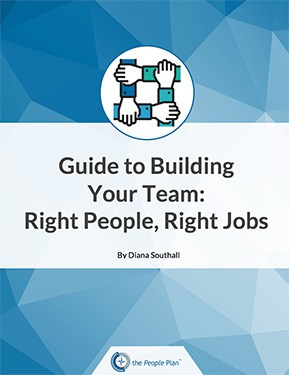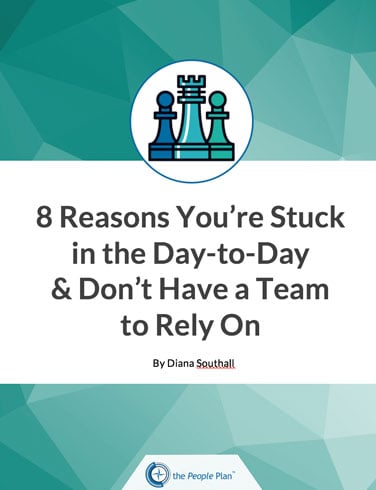
by thepeopleplan | Jul 10, 2012 | Uncategorized
I have yet to meet a supervisor, manager, executive or business owner who tells me that their organization has it “easy “in the current economic climate.
What I do hear is that they have to:
- Adapt to a changing competitive environment
- Do more with less
- Consider how to keep profits with rising costs and lowering prices
- Respond faster to customer requests and orders
All of these business requirements trickle down to employees.
Surveys show that employees feel they are:
- expected to do the impossible
- overwhelmed with too much work
- 40% are stressed to the point of feeling “burned out”
- 64% are physically exhausted when they get home from work
This is not a recipe for creative products or world-class customer service.
If employees do not have the resources to do their jobs (time, information, approval, authority, the rest of the organization delivering on promises) they will become frustrated, lose engagement and then individual and company performance will decline.
A key element to improving your working conditions and employee work load is to collect employee suggestions and issues and then systematically address with process improvement.
Read more in Verne Harnish/ Gazelle article Dehassling your company
Image courtesy of David Castillo Dominici at FreeDigitalPhotos.net

by thepeopleplan | May 17, 2012 | Uncategorized
Compensation (base pay) is the most expensive reward you offer employees yet it is not very impactful in retaining or motivating employees. (It is in attracting new employees and a factor in their decision to take your job offer). Your pay practices can also become a major de-motivator if employees feel that they are not paid fairly compared to other workers.
The problem:
- Surveys find that about half of employees do not know how their compensation is determined.
- Many organizations say that they “pay for performance” yet a top performer might receive a 4% raise instead of a 3% raise—not exactly providing a meaningful difference to reward extra effort.
- Incentive plans often create unintended consequences of discouraging teamwork, encouraging behaviors that do not serve the customer, or become an expected entitlement and not a motivator or perceived reward for great performance.
The solution:
Many theories of motivation and business authors (Dan Pink, Brad Ham) share the philosophy of Total Rewards—provide fair and market competitive wages and then provide the other Rewards to engage your staff. (See our series on 13 Total Rewards in the Rewards category of our blog).
As for incentives (variable pay), these plans need to be carefully designed and communicated so that they align individual effort with business goals and then share a reasonable part of the gain. Give employees an upside when they and the organization does well and you protect your bottom line for the lean times.
Contact us to learn more about the WNY Compensation & Benefits Survey to benchmark your organization to others in the region.
Image courtesy of Stuart Miles at FreeDigitalPhotos.net

by thepeopleplan | Apr 26, 2012 | Uncategorized
If pay were the only reason employees worked, only the highest-paying employer would have staff and no one would work at not for profits!
Employees look at more than just compensation when they consider a job offer or when they consider leaving your organization—they look at “Total Rewards”.
These are all the rewards elements of a job that impact an employee’s satisfaction with the job, and the key to find, keep and motivate more Right People on your staff.
The “Best Places to Work” are rated this way because they provide a Total Rewards package that employees find favorable.
A flexible and customized Total Rewards package allows your organization to attract, retain and reward top performers – which provides a competitive advantage for your organization.
Don’t just take our word for it!
According to Aon Hewitt’s global Best Employer report “research reveals how organizations differentiate and achieve a competitive advantage through their people. The benefits of being a Best Employer are well documented, from improved retention to increased productivity. Best Employers are distinguished by high levels of employee engagement, which results in lower turnover, larger talent pools, and better financial performance.
Organizations with high levels of engagement to outperform the stock market index with returns 22% higher than average; companies with low engagement had returns 28% lower than average.”
Link to full Aon Hewitt report on Employee Engagement
Consider more than your base pay: 
Employers often look at compensation as the main (and most expensive) element to achieve employee satisfaction—but there is a multitude of research that the quality of manager- employee interaction is far more important to employee satisfaction and retention (among 11 other rewards).
For example, according to a recent study by the Total Rewards organization World at Work, recent college graduates rate pay as #5 in importance, behind opportunity, flexible work hours and a friendly work environment.
How do you find out if employees are satisfied with your Rewards—you ask them! The best way to measure changes in employee satisfaction and engagement is to conduct an annual Total Rewards survey. If you have different locations or shifts the results can be summarized to if there are any meaningful differences among groups of workers (there usually are). This allows you to provide a flexible Total Rewards package that appeals to different types of workers with different interests.
Contact us to receive a free article on the Total Rewards model, and process to identify employee needs and develop a custom and flexible Total Reward program for your unique organization.
Image courtesy of scottchan at FreeDigitalPhotos.net







